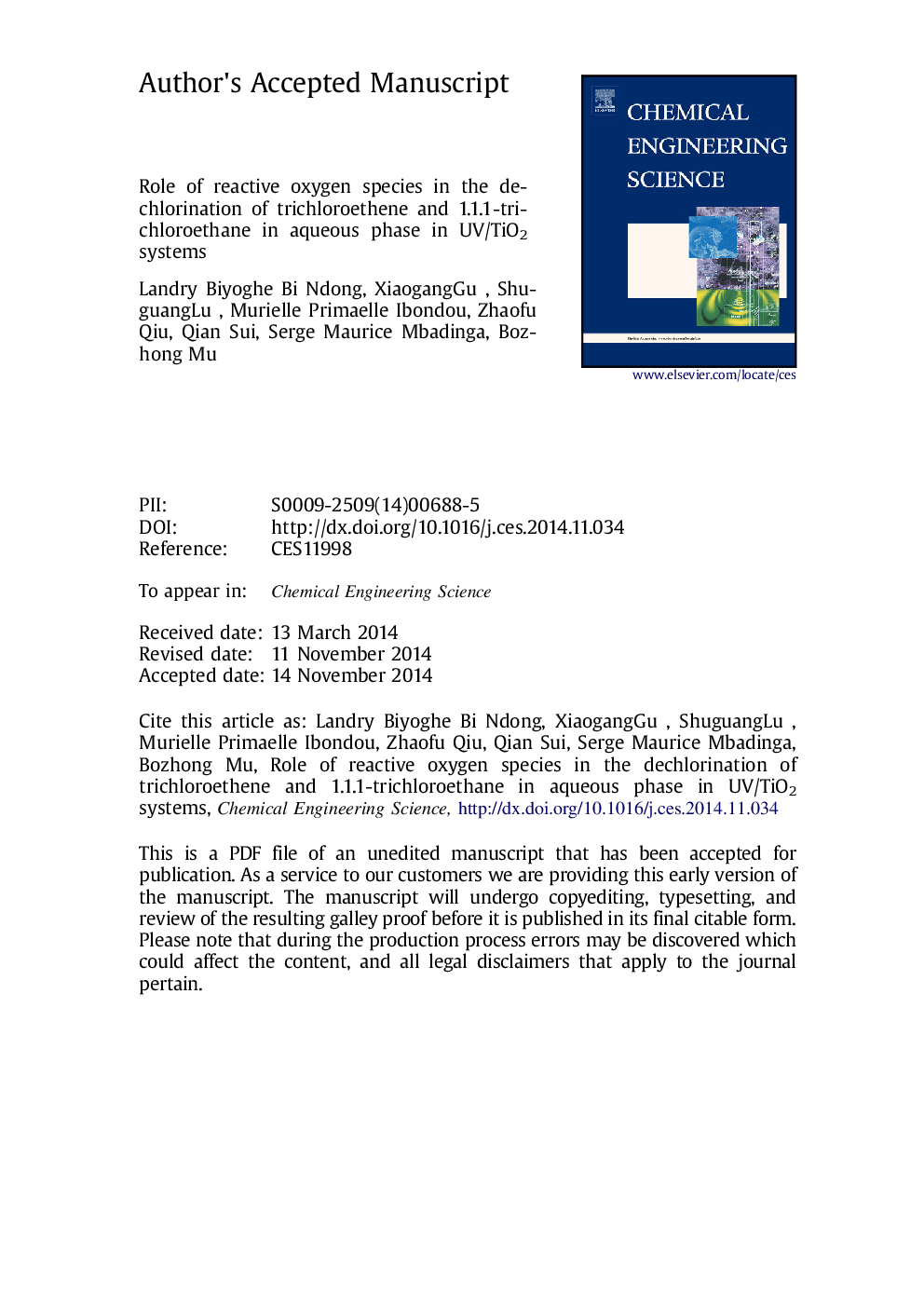| کد مقاله | کد نشریه | سال انتشار | مقاله انگلیسی | نسخه تمام متن |
|---|---|---|---|---|
| 6590558 | 456858 | 2015 | 35 صفحه PDF | دانلود رایگان |
عنوان انگلیسی مقاله ISI
Role of reactive oxygen species in the dechlorination of trichloroethene and 1.1.1-trichloroethane in aqueous phase in UV/TiO2 systems
دانلود مقاله + سفارش ترجمه
دانلود مقاله ISI انگلیسی
رایگان برای ایرانیان
کلمات کلیدی
موضوعات مرتبط
مهندسی و علوم پایه
مهندسی شیمی
مهندسی شیمی (عمومی)
پیش نمایش صفحه اول مقاله

چکیده انگلیسی
The performance of trichloroethene (TCE) and 1.1.1-trichloroethane (TCA) degradation and dechlorination in aqueous solution using UV and UV/TiO2 was investigated. The effects of pH and the roles of the reactive oxygen species generated during the degradation of the target contaminant were evaluated. The TiO2 was synthesized using a simple hydrothermal solution containing tetrabutyl-titanate and hydrofluoric acid and was characterized by X-ray diffraction (XRD), BrunauerâEmmettâTeller (BET) analysis, transmission electron microscopy (TEM) and X-ray photoelectron spectroscopy (XPS). The results showed that the TiO2, which was in the form of anatase, consisted of well-defined sheet-shaped structures with a rectangular outlineâ¡Ti-F bonds that were formed on the surfaces of photocatalysts. TCE and TCA were completely degraded (100%) in 60 and 90Â min of illumination, and the degradation of TCE followed the pseudo-first order kinetic model, while the degradation of TCA showed a slow degradation stage initially followed by a fast stage later. The inhibitive effects of pH on TCE degradation were negligible because complete degradation occurred in all the tested pH solutions. Instead, the pH affected the degradation of TCA. Probe compound tests using nitrobenzene (NB) and tetrachloromethane (CT) identified the generation of hydroxyl radicals (
- OH) and the superoxide radical anion (O2
- â) in the UV/TiO2 system. Free radical quenching studies demonstrated that all of the studied reactive oxidative species contributed to the TCE and TCA degradation. However, O2
- â and
- OH were main detected radicals and contributed more to the degradation process than the 3O2 radical. It is believed that the results from this study can be used to support further UV/TiO2 studies for remediating groundwater contaminated with chlorinated solvents.
- OH) and the superoxide radical anion (O2
- â) in the UV/TiO2 system. Free radical quenching studies demonstrated that all of the studied reactive oxidative species contributed to the TCE and TCA degradation. However, O2
- â and
- OH were main detected radicals and contributed more to the degradation process than the 3O2 radical. It is believed that the results from this study can be used to support further UV/TiO2 studies for remediating groundwater contaminated with chlorinated solvents.
ناشر
Database: Elsevier - ScienceDirect (ساینس دایرکت)
Journal: Chemical Engineering Science - Volume 123, 17 February 2015, Pages 367-375
Journal: Chemical Engineering Science - Volume 123, 17 February 2015, Pages 367-375
نویسندگان
Landry Biyoghe Bi Ndong, Xiaogang Gu, Shuguang Lu, Murielle Primaelle Ibondou, Zhaofu Qiu, Qian Sui, Serge Maurice Mbadinga, Bozhong Mu,